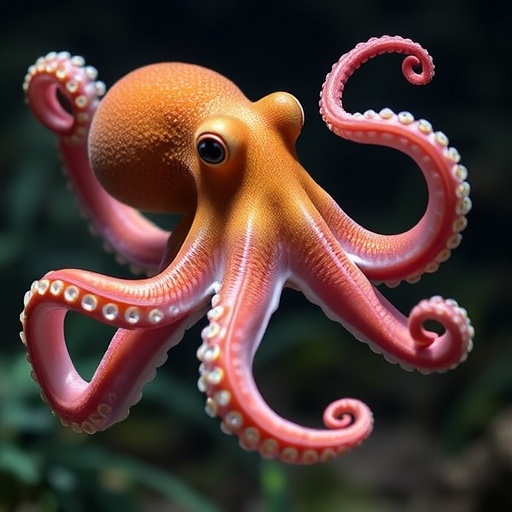In a groundbreaking exploration of cephalopod biomechanics and behavior, new research published in Scientific Reports unveils the extraordinary sophistication of octopus arm usage and flexibility. This study delves deep into the motor control and task-specific specialization of the octopus’s eight highly dexterous limbs, revealing nuances that could revolutionize our understanding of invertebrate intelligence and inspire advancements in robotic design.
Octopuses, renowned for their remarkable cognitive abilities and unparalleled physical adaptability, possess arms that defy conventional limb structure. Each arm houses a unique integration of four distinct muscle groups—transverse, longitudinal, oblique, and circular—arranged around a central nerve cord. This intricate muscular architecture enables the arms to execute an astonishing array of deformations and movements, from precise curling and elongation to complex rolling motions. These movements underpin a wide range of behaviors such as foraging, locomotion, and defensive tactics.
Despite this known muscular versatility, until now, the extent to which wild octopuses utilize individual arms for specific functions, and how they coordinate these limbs during natural behaviors, remained a mystery. The research team, led by Chelsea Bennice, systematically analyzed footage of wild octopuses from both the Atlantic Ocean and the Caribbean Sea, spanning nearly a decade of field observations. This comprehensive study encompassed multiple species closely related in evolution, including Octopus vulgaris, Octopus insularis, and Octopus americanus.
Through meticulous frame-by-frame analysis of twenty-five separate one-minute video segments, the researchers identified fifteen distinct behavioral categories, ranging from crawling and reaching to manipulative actions. For each instance, they catalogued which arms were employed, the nature of their specific actions—such as curling or splaying—and the precise muscular deformations involved, including elongation and rotation. This approach allowed the team to map the functional deployment of each arm in natural contexts with unprecedented precision.
Strikingly, the study found that all eight arms could perform the full gamut of muscular deformations and actions. This universal mechanical capability was present regardless of individual or species, underscoring the inherent flexibility encoded in the octopus’s neuromuscular system. However, despite this uniform potential, octopuses demonstrated clear preferences in arm usage, employing their front four arms significantly more often than the rear four. Quantitatively, the front arms accounted for approximately 64% of arm usage across behaviors, while the rear arms accounted for 36%.
This preferential utilization aligns with task specialization: the anterior limbs predominantly served exploratory and environmental interaction roles, probing landscapes and objects with intricate manipulations. Conversely, the posterior arms were more frequently recruited for locomotive functions, propelling the animal and supporting body positioning. Two rear-arm actions—“roll” and “stilt”—were notably more common, involving coordinated arm movements to achieve smooth ground contact or to raise the body for better vantage or maneuvering, respectively.
The revelation that octopuses exhibit task-specific arm specialization challenges earlier assumptions that these animals employ their limbs interchangeably without preferred lateralization or functional asymmetry. Previously, such limb specialization was thought to be limited mostly to vertebrates, particularly primates, rodents, and some fish species. This research, therefore, contributes a novel dimension to the study of motor control and lateralization in invertebrates, suggesting convergent evolutionary solutions for efficient limb use across disparate taxa.
At the neural level, the octopus’s peripheral nervous system plays a pivotal role in this limb autonomy and specialization. Each arm contains a dense nerve cord capable of local processing, allowing substantial independent control apart from the central brain. This decentralized orchestration might facilitate simultaneous but distinct motor patterns across arms, enabling the animal to execute multitasking behaviors vital for survival in dynamic marine environments.
The biomechanical insights uncovered in this research have profound implications beyond biology. Engineers and roboticists have long been inspired by the octopus’s pliable limbs to develop soft robotics—machines designed to mimic the dexterity and adaptability of biological tissues. Understanding the fine-grained muscular and neural coordination underlying octopus arm specialization provides a valuable blueprint for designing robotic limbs capable of complex, task-specific movements in unstructured environments, promising advancements in fields such as medical devices, underwater exploration, and search-and-rescue operations.
Furthermore, this study highlights the evolutionary ingenuity of octopuses, emphasizing their highly adaptive morphological and behavioral repertoire. The ability to selectively deploy specific arms for distinct tasks enhances the animal’s efficiency and effectiveness in interacting with its surroundings, optimizing foraging success, predator avoidance, and locomotor agility.
This research also sets the stage for future inquiries into the sensory modalities linked to arm use. Since octopus arms are richly endowed with tactile and chemical sensors, their preferential use in exploration likely correlates with sensory specialization and neural processing strategies, an area ripe for further investigation. Understanding how sensory feedback integrates with motor commands at both the central and peripheral nervous system levels will enrich our grasp of cephalopod intelligence.
Moreover, the findings may shed light on the developmental and genetic mechanisms governing limb specialization in octopuses. Discovering how neural circuits differentiate or bias control towards particular limbs could inform broader questions about motor system evolution and plasticity.
In sum, this study not only deepens our comprehension of octopus anatomy and behavior but also bridges biological knowledge with technological innovation, illustrating how detailed naturalistic observations can fuel bio-inspired engineering advances. The intricate dance of octopus arms, choreographed by the interplay of muscular architecture and neural control, remains an inspiring testament to the complexity evolved by even the most unusual creatures in our oceans.
Subject of Research: Animals
Article Title: Octopus arm flexibility facilitates complex behaviors in diverse natural environments
News Publication Date: 11-Sep-2025
Web References: 10.1038/s41598-025-10674-y
Keywords: Octopus, arm flexibility, neuromuscular control, limb specialization, soft robotics, cephalopod behavior, motor control, invertebrate intelligence, decentralized nervous system
Tags: advanced robotic design inspirationcephalopod biomechanics researchcognitive abilities of cephalopodsinvertebrate intelligence studiesmarine biology research findingsmuscle architecture in octopus armsoctopus arm specializationoctopus limb flexibilityoctopus locomotion strategiesoctopus motor controltask-specific arm usage in octopuseswild octopus behavior analysis





